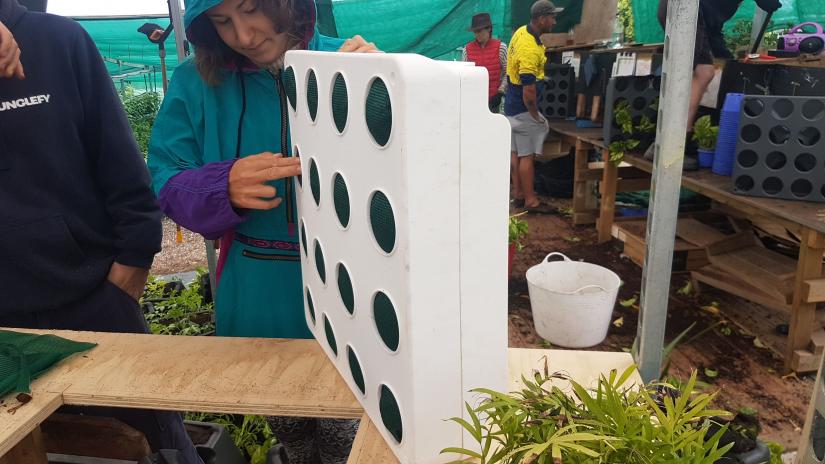Vertical gardens are made up of plants growing either directly on a wall or on adjacent supporting structures. Studies have shown these green walls remove pollution from the air, promote biodiversity and naturally control the temperature inside buildings. They can also help with noise reduction.
Now, a collaboration between researchers at the University of Technology Sydney (UTS) and the horticultural industry is seeking to encourage wider take-up of ‘do-it-yourself’ green walls at the community level, particularly in space-constrained urban areas.
“When you think of green walls at the moment, you think of projects like Central Park,” says Dr Peter Irga, a postdoctoral Research Fellow in air quality research with the School of Civil and Environmental Engineering at the University of Technology Sydney (UTS). “But for the person at home thinking about how to increase greenery – whether that’s in their local area, in their courtyard or on their balcony – this is the way to go.”
They not only enable the presence of nature but also allow people to connect with nature.
— Byron de Kock
A multidisciplinary team of researchers from UTS, in science, engineering and design, have worked with horticultural industry group Hort Innovation to develop a free, science-based online resource to give individuals and communities the confidence to install their own living walls.
The ‘It’s time to grow up’ digital resource simplify the process of vertical gardening for individuals and local communities, covering topics such as choice of structure and plants, irrigation and maintenance. Various design options are star-rated in areas such as ease of construction and cost.
Hort Innovation Head of Research and Development, Byron De Kock, says the aim of the project is to simplify vertical greening at a community level.
“Green walls allow plants to be grown in dense urban areas where spatial constraints may limit the presence of traditional urban forestry, such as parks and street trees,” he says. “They provide a modern approach to urban greening … they not only enable the presence of nature but also allow people to connect with nature as they build, plant and maintain these living systems.”
The natural air cleaning ability of this biological system leads to improved air quality.
— Dr Peter Irga
The roots of the DIY vertical gardens project are in ongoing research by the UTS Plants and Environment Quality Research Group into the health and social benefits of plants, including from breathing walls.
Researchers including Dr Irga also studied government policy internationally on green walls, and surveyed every local government area in each of Australia’s major cities to ascertain what sort of support was being provided locally.
The research highlighted lack of knowledge as a curb on wider take-up in Australia, identifying the need to get communities involved and leading to the Hort Frontiers Green Cities funded project.
“Thermal regulation is one of the most researched benefits of green walls,” explains Dr Irga. “This means green walls can reduce high temperatures within buildings by intercepting solar radiation and through evaporative cooling.” Conversely, green walls have been shown to have insulation benefits in cold climates.
“These mechanisms enable less reliance upon heaters and air conditioners and allow reductions in energy consumption.
“Most exciting, though, is that green walls are able to remove pollution from the air,” he says. The plants can capture airborne particles on their foliage and, with the associated microbial community, degrade a range of gaseous pollutants, including volatile organic compounds (VOCs).
VOCs are given off by motor vehicles, fires, industrial processes and consumer products like paint. Some are highly toxic and prolonged exposure may increase the risk of health problems.
“The natural air cleaning ability of this biological system leads to improved air quality in the home and in urban settings,” Dr Irga says
CO2-absorbing vertical gardens are one tangible way for individuals to help mitigate climate change, he says. “But, climate change aside, if I said: ‘What if we just make this community a better place?’ – everyone would be on board with that.
“There's a known association between increased biodiversity and increased personal health and happiness. When people live in a more diverse area, with people, plants and animals, they are happier in general.”
Benefits of green walls
- connect with nature
- improved wellbeing
- community engagement
- reduced temperatures
The benefits of green walls extend beyond just creating a beautiful space.
Green walls can help to:
- insulate buildings
- increase energy efficiency
- aid in thermal control
The plants in green walls can:
- filter air pollutants
- create eco-friendly habitats for birds and insects
Green walls create a restorative atmosphere.
Viewing greenery can:
- increase productivity and promote positive mood
- promote psychological wellbeing
Source: itstimetogrowup.com.au/faq
report
P.J. Irga, et al, The distribution of green walls and green roofs throughout Australia: Do policy instruments influence the frequency of projects?, Urban Forestry & Urban Greening, 24, 2017, 164-174
Research team
-
Chancellor's Postdoctoral Research Fellow, School of Civil and Environmental Engineering
-
Professor, School of Built Environment
-
Senior Lecturer, School of Life Sciences
-
Professor, School of Architecture
-
 Julia YeoResearch Engineer, Faculty of Engineering and Information Technology
Julia YeoResearch Engineer, Faculty of Engineering and Information Technology -
Ashley DouglasResearch Associate, Science
-
Thomas PettitResearch Engineer, Faculty of Engineering and Information Technology
Faculty and research centre
- Faculty of Science
- Faculty of Engineering and Information Technology
- Faculty of Design, Architecture and Building
- UTS Plants and Environment Quality Research Group
Funded by
- Hort Innovation







